【TensorFlow】基于ssd_mobilenet模型实现目标检测
最近工作的项目使用了TensorFlow中的目标检测技术,通过训练自己的样本集得到模型来识别游戏中的物体,在这里总结下。
本文介绍在Windows系统下,使用TensorFlow的object detection API来训练自己的数据集,所用的模型为ssd_mobilenet,当然也可以使用其他模型,包括ssd_inception、faster_rcnn、rfcnn_resnet等,其中,ssd模型在各种模型中性能最好,所以便采用它来进行训练。
配置环境
1. 在GitHub上下载所需的models文件,地址:https://github.com/tensorflow/models
2. 安装pillow、Jupyter、matplotlib、lxml,打开anaconda prompt输入以下命令,并安装成功
pip install pillow
pip install jupyter
pip install matplotlib
pip install lxml
3. 编译protobuf,object detection API是使用protobuf来训练模型和配置参数的,所以得先编译protobuf,下载地址:https://github.com/google/protobuf/releases,具体配置过程可参考:https://blog.csdn.net/dy_guox/article/details/79081499 。
制作自己的样本集
1. 下载labelImg,并标注自己收集的图片样本,标注的标签自动保存为xml格式,
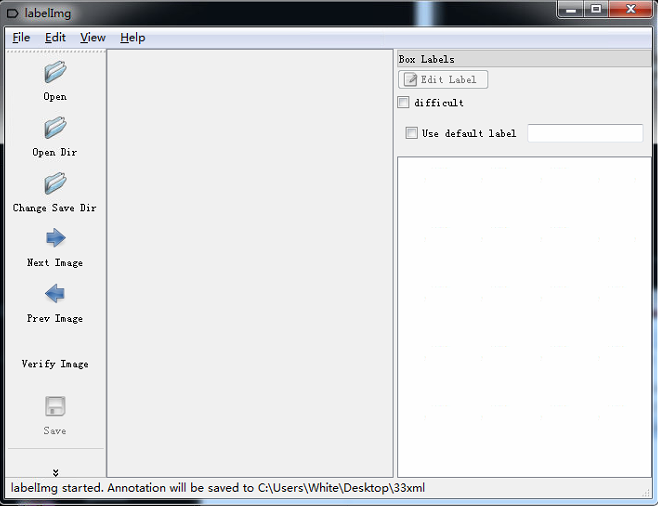
<annotation> <folder>images1</folder> <filename>0.png</filename> <path>C:\Users\White\Desktop\images1\0.png</path> <source> <database>Unknown</database> </source> <size> <width>1080</width> <height>1920</height> <depth>3</depth> </size> <segmented>0</segmented> <object> <name>box</name> <pose>Unspecified</pose> <truncated>0</truncated> <difficult>0</difficult> <bndbox> <xmin>345</xmin> <ymin>673</ymin> <xmax>475</xmax> <ymax>825</ymax> </bndbox> </object> <object> <name>box</name> <pose>Unspecified</pose> <truncated>0</truncated> <difficult>0</difficult> <bndbox> <xmin>609</xmin> <ymin>1095</ymin> <xmax>759</xmax> <ymax>1253</ymax> </bndbox> </object> </annotation>
2. 在工程文件夹下新建以下目录,并将所有的样本图片放入images文件夹,将标注保存的xml文件保存到merged_xml文件夹,
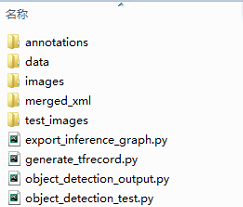

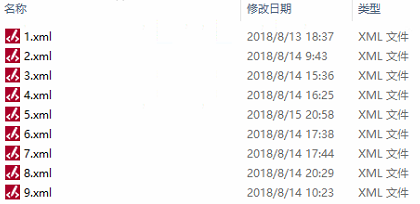
将样本数据转换为TFRecord格式
1. 新建train_test_split.py把xml数据集分为了train 、test、 validation三部分,并存储在annotations文件夹中,train为训练集占76.5%,test为测试集10%,validation为验证集13.5%,train_test_split.py代码如下:
import os import random import time import shutil xmlfilepath=r'merged_xml' saveBasePath=r"./annotations" trainval_percent=0.9 train_percent=0.85 total_xml = os.listdir(xmlfilepath) num=len(total_xml) list=range(num) tv=int(num*trainval_percent) tr=int(tv*train_percent) trainval= random.sample(list,tv) train=random.sample(trainval,tr) print("train and val size",tv) print("train size",tr) # print(total_xml[1]) start = time.time() # print(trainval) # print(train) test_num=0 val_num=0 train_num=0 # for directory in ['train','test',"val"]: # xml_path = os.path.join(os.getcwd(), 'annotations/{}'.format(directory)) # if(not os.path.exists(xml_path)): # os.mkdir(xml_path) # # shutil.copyfile(filePath, newfile) # print(xml_path) for i in list: name=total_xml[i] # print(i) if i in trainval: #train and val set # ftrainval.write(name) if i in train: # ftrain.write(name) # print("train") # print(name) # print("train: "+name+" "+str(train_num)) directory="train" train_num+=1 xml_path = os.path.join(os.getcwd(), 'annotations/{}'.format(directory)) if(not os.path.exists(xml_path)): os.mkdir(xml_path) filePath=os.path.join(xmlfilepath,name) newfile=os.path.join(saveBasePath,os.path.join(directory,name)) shutil.copyfile(filePath, newfile) else: # fval.write(name) # print("val") # print("val: "+name+" "+str(val_num)) directory="validation" xml_path = os.path.join(os.getcwd(), 'annotations/{}'.format(directory)) if(not os.path.exists(xml_path)): os.mkdir(xml_path) val_num+=1 filePath=os.path.join(xmlfilepath,name) newfile=os.path.join(saveBasePath,os.path.join(directory,name)) shutil.copyfile(filePath, newfile) # print(name) else: #test set # ftest.write(name) # print("test") # print("test: "+name+" "+str(test_num)) directory="test" xml_path = os.path.join(os.getcwd(), 'annotations/{}'.format(directory)) if(not os.path.exists(xml_path)): os.mkdir(xml_path) test_num+=1 filePath=os.path.join(xmlfilepath,name) newfile=os.path.join(saveBasePath,os.path.join(directory,name)) shutil.copyfile(filePath, newfile) # print(name) # End time end = time.time() seconds=end-start print("train total : "+str(train_num)) print("validation total : "+str(val_num)) print("test total : "+str(test_num)) total_num=train_num+val_num+test_num print("total number : "+str(total_num)) print( "Time taken : {0} seconds".format(seconds))

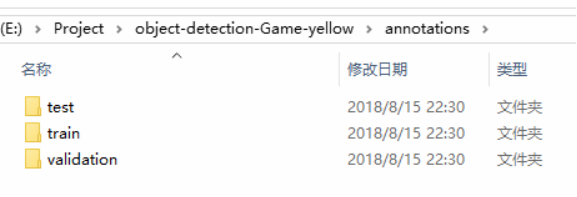
2. 把xml转换成csv文件,新建xml_to_csv.py,,运行代码前,需要建一个data目录,用来放生成的csv文件,结果和代码如下:
import os import glob import pandas as pd import xml.etree.ElementTree as ET def xml_to_csv(path): xml_list = [] for xml_file in glob.glob(path + '/*.xml'): tree = ET.parse(xml_file) root = tree.getroot() # print(root) print(root.find('filename').text) for member in root.findall('object'): value = (root.find('filename').text, int(root.find('size')[0].text), #width int(root.find('size')[1].text), #height member[0].text, int(member[4][0].text), int(float(member[4][1].text)), int(member[4][2].text), int(member[4][3].text) ) xml_list.append(value) column_name = ['filename', 'width', 'height', 'class', 'xmin', 'ymin', 'xmax', 'ymax'] xml_df = pd.DataFrame(xml_list, columns=column_name) return xml_df def main(): for directory in ['train','test','validation']: xml_path = os.path.join(os.getcwd(), 'annotations/{}'.format(directory)) # image_path = os.path.join(os.getcwd(), 'merged_xml') xml_df = xml_to_csv(xml_path) # xml_df.to_csv('whsyxt.csv', index=None) xml_df.to_csv('data/whsyxt_{}_labels.csv'.format(directory), index=None) print('Successfully converted xml to csv.') main()
运行结果如下:
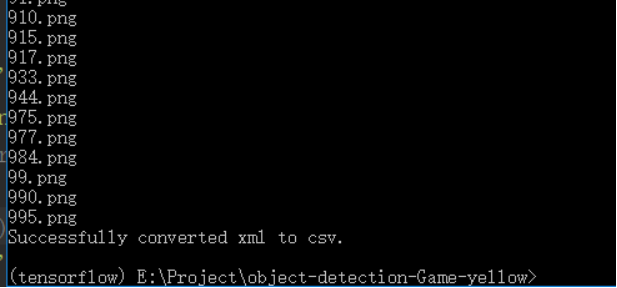
在data文件夹下生成的csv文件:

3. 生成tfrecords文件,python文件名为generate_tfrecord.py,代码如下:
1 from __future__ import division 2 from __future__ import print_function 3 from __future__ import absolute_import 4 5 import os 6 import io 7 import pandas as pd 8 import tensorflow as tf 9 10 from PIL import Image 11 from object_detection.utils import dataset_util 12 from collections import namedtuple, OrderedDict 13 14 flags = tf.app.flags 15 flags.DEFINE_string('csv_input', '', 'Path to the CSV input') 16 flags.DEFINE_string('output_path', '', 'Path to output TFRecord') 17 FLAGS = flags.FLAGS 18 # TO-DO replace this with label map 19 def class_text_to_int(row_label,filename): 20 if row_label == 'person': 21 return 1 22 elif row_label == 'investigator': 23 return 2 24 elif row_label == 'collector': 25 return 3 26 elif row_label == 'wolf': 27 return 4 28 elif row_label == 'skull': 29 return 5 30 elif row_label == 'inferno': 31 return 6 32 elif row_label == 'stone_blame': 33 return 7 34 elif row_label == 'green_jelly': 35 return 8 36 elif row_label == 'blue_jelly': 37 return 9 38 elif row_label == 'box': 39 return 10 40 elif row_label == 'golden_box': 41 return 11 42 elif row_label == 'silver_box': 43 return 12 44 elif row_label == 'jar': 45 return 13 46 elif row_label == 'purple_jar': 47 return 14 48 elif row_label == 'purple_weapon': 49 return 15 50 elif row_label == 'blue_weapon': 51 return 16 52 elif row_label == 'blue_shoe': 53 return 17 54 elif row_label == 'blue_barde': 55 return 18 56 elif row_label == 'blue_ring': 57 return 19 58 elif row_label == 'badge': 59 return 20 60 elif row_label == 'dragon_stone': 61 return 21 62 elif row_label == 'lawn': 63 return 22 64 elif row_label == 'mine': 65 return 23 66 elif row_label == 'portal': 67 return 24 68 elif row_label == 'tower': 69 return 25 70 elif row_label == 'hero_stone': 71 return 26 72 elif row_label == 'oracle_stone': 73 return 27 74 elif row_label == 'arena': 75 return 28 76 elif row_label == 'gold_ore': 77 return 29 78 elif row_label == 'relic': 79 return 30 80 elif row_label == 'ancient': 81 return 31 82 elif row_label == 'house': 83 return 32 84 else: 85 print("------------------nonetype:", filename) 86 None 87 88 def split(df, group): 89 data = namedtuple('data', ['filename', 'object']) 90 gb = df.groupby(group) 91 return [data(filename, gb.get_group(x)) for filename, x in zip(gb.groups.keys(), gb.groups)] 92 93 94 def create_tf_example(group, path): 95 with tf.gfile.GFile(os.path.join(path, '{}'.format(group.filename)), 'rb') as fid: 96 encoded_jpg = fid.read() 97 encoded_jpg_io = io.BytesIO(encoded_jpg) 98 image = Image.open(encoded_jpg_io) 99 width, height = image.size 100 101 filename = group.filename.encode('utf8') 102 image_format = b'png' 103 xmins = [] 104 xmaxs = [] 105 ymins = [] 106 ymaxs = [] 107 classes_text = [] 108 classes = [] 109 110 for index, row in group.object.iterrows(): 111 xmins.append(row['xmin'] / width) 112 xmaxs.append(row['xmax'] / width) 113 ymins.append(row['ymin'] / height) 114 ymaxs.append(row['ymax'] / height) 115 classes_text.append(row['class'].encode('utf8')) 116 classes.append(class_text_to_int(row['class'], group.filename)) 117 118 tf_example = tf.train.Example(features=tf.train.Features(feature={ 119 'image/height': dataset_util.int64_feature(height), 120 'image/width': dataset_util.int64_feature(width), 121 'image/filename': dataset_util.bytes_feature(filename), 122 'image/source_id': dataset_util.bytes_feature(filename), 123 'image/encoded': dataset_util.bytes_feature(encoded_jpg), 124 'image/format': dataset_util.bytes_feature(image_format), 125 'image/object/bbox/xmin': dataset_util.float_list_feature(xmins), 126 'image/object/bbox/xmax': dataset_util.float_list_feature(xmaxs), 127 'image/object/bbox/ymin': dataset_util.float_list_feature(ymins), 128 'image/object/bbox/ymax': dataset_util.float_list_feature(ymaxs), 129 'image/object/class/text': dataset_util.bytes_list_feature(classes_text), 130 'image/object/class/label': dataset_util.int64_list_feature(classes), 131 })) 132 return tf_example 133 134 135 def main(_): 136 writer = tf.python_io.TFRecordWriter(FLAGS.output_path) 137 path = os.path.join(os.getcwd(), 'images') 138 examples = pd.read_csv(FLAGS.csv_input) 139 grouped = split(examples, 'filename') 140 num=0 141 for group in grouped: 142 num+=1 143 tf_example = create_tf_example(group, path) 144 writer.write(tf_example.SerializeToString()) 145 if(num%100==0): #每完成100个转换,打印一次 146 print(num) 147 148 writer.close() 149 output_path = os.path.join(os.getcwd(), FLAGS.output_path) 150 print('Successfully created the TFRecords: {}'.format(output_path)) 151 152 153 if __name__ == '__main__': 154 tf.app.run()
其中,20~83行应改成在样本集中标注的类别,我这里总共有32个类别,字符串row_label应与labelImg中标注的名称相同。
现将训练集转换为tfrecord格式,输入如下命令:
python generate_tfrecord.py --csv_input=data/whsyxt_train_labels.csv --output_path=data/whsyxt_train.tfrecord


类似的,我们可以输入如下命令,将验证集和测试集也转换为tfrecord格式,
python generate_tfrecord.py --csv_input=data/whsyxt_validation_labels.csv --output_path=data/whsyxt_validation.tfrecord
python generate_tfrecord.py --csv_input=data/whsyxt_test_labels.csv --output_path=data/whsyxt_test.tfrecord
都执行成功后,获得如下文件,

训练
1. 在工程文件夹data目录下创建标签分类的配置文件(label_map.pbtxt),需要检测几种目标,将创建几个id,代码如下:
item { id: 1 # id从1开始编号 name: 'person' } item { id: 2 name: 'investigator' } item { id: 3 name: 'collector' } item { id: 4 name: 'wolf' } item { id: 5 name: 'skull' } item { id: 6 name: 'inferno' } item { id: 7 name: 'stone_blame' } item { id: 8 name: 'green_jelly' } item { id: 9 name: 'blue_jelly' } item { id: 10 name: 'box' } item { id: 11 name: 'golden_box' } item { id: 12 name: 'silver_box' } item { id: 13 name: 'jar' } item { id: 14 name: 'purple_jar' } item { id: 15 name: 'purple_weapon' } item { id: 16 name: 'blue_weapon' } item { id: 17 name: 'blue_shoe' } item { id: 18 name: 'blue_barde' } item { id: 19 name: 'blue_ring' } item { id: 20 name: 'badge' } item { id: 21 name: 'dragon_stone' } item { id: 22 name: 'lawn' } item { id: 23 name: 'mine' } item { id: 24 name: 'portal' } item { id: 25 name: 'tower' } item { id: 26 name: 'hero_stone' } item { id: 27 name: 'oracle_stone' } item { id: 28 name: 'arena' } item { id: 29 name: 'gold_ore' } item { id: 30 name: 'relic' } item { id: 31 name: 'ancient' } item { id: 32 name: 'house' }
2. 配置管道配置文件,找到 models\research\object_detection\samples\configs\ssd_inception_v2_pets.config文件,复制到data文件夹下,修改之后代码如下:
1 # SSD with Mobilenet v1, configured for Oxford-IIIT Pets Dataset. 2 # Users should configure the fine_tune_checkpoint field in the train config as 3 # well as the label_map_path and input_path fields in the train_input_reader and 4 # eval_input_reader. Search for "PATH_TO_BE_CONFIGURED" to find the fields that 5 # should be configured. 6 7 model { 8 ssd { 9 num_classes: 32 10 box_coder { 11 faster_rcnn_box_coder { 12 y_scale: 10.0 13 x_scale: 10.0 14 height_scale: 5.0 15 width_scale: 5.0 16 } 17 } 18 matcher { 19 argmax_matcher { 20 matched_threshold: 0.45 21 unmatched_threshold: 0.35 22 ignore_thresholds: false 23 negatives_lower_than_unmatched: true 24 force_match_for_each_row: true 25 } 26 } 27 similarity_calculator { 28 iou_similarity { 29 } 30 } 31 anchor_generator { 32 ssd_anchor_generator { 33 num_layers: 6 34 min_scale: 0.2 35 max_scale: 0.95 36 aspect_ratios: 1.0 37 aspect_ratios: 2.0 38 aspect_ratios: 0.5 39 aspect_ratios: 3.0 40 aspect_ratios: 0.3333 41 } 42 } 43 image_resizer { 44 fixed_shape_resizer { 45 height: 300 46 width: 300 47 } 48 } 49 box_predictor { 50 convolutional_box_predictor { 51 min_depth: 0 52 max_depth: 0 53 num_layers_before_predictor: 0 54 use_dropout: false 55 dropout_keep_probability: 0.8 56 kernel_size: 1 57 box_code_size: 4 58 apply_sigmoid_to_scores: false 59 conv_hyperparams { 60 activation: RELU_6, 61 regularizer { 62 l2_regularizer { 63 weight: 0.00004 64 } 65 } 66 initializer { 67 truncated_normal_initializer { 68 stddev: 0.03 69 mean: 0.0 70 } 71 } 72 batch_norm { 73 train: true, 74 scale: true, 75 center: true, 76 decay: 0.9997, 77 epsilon: 0.001, 78 } 79 } 80 } 81 } 82 feature_extractor { 83 type: 'ssd_mobilenet_v1' 84 min_depth: 16 85 depth_multiplier: 1.0 86 conv_hyperparams { 87 activation: RELU_6, 88 regularizer { 89 l2_regularizer { 90 weight: 0.00004 91 } 92 } 93 initializer { 94 truncated_normal_initializer { 95 stddev: 0.03 96 mean: 0.0 97 } 98 } 99 batch_norm { 100 train: true, 101 scale: true, 102 center: true, 103 decay: 0.9997, 104 epsilon: 0.001, 105 } 106 } 107 } 108 loss { 109 classification_loss { 110 weighted_sigmoid { 111 } 112 } 113 localization_loss { 114 weighted_smooth_l1 { 115 } 116 } 117 hard_example_miner { 118 num_hard_examples: 3000 119 iou_threshold: 0.99 120 loss_type: CLASSIFICATION 121 max_negatives_per_positive: 3 122 min_negatives_per_image: 0 123 } 124 classification_weight: 1.0 125 localization_weight: 1.0 126 } 127 normalize_loss_by_num_matches: true 128 post_processing { 129 batch_non_max_suppression { 130 score_threshold: 1e-8 131 iou_threshold: 0.6 132 max_detections_per_class: 100 133 max_total_detections: 100 134 } 135 score_converter: SIGMOID 136 } 137 } 138 } 139 140 train_config: { 141 batch_size: 24 142 optimizer { 143 rms_prop_optimizer: { 144 learning_rate: { 145 exponential_decay_learning_rate { 146 initial_learning_rate: 0.004 147 decay_steps: 1000 148 decay_factor: 0.95 149 } 150 } 151 momentum_optimizer_value: 0.9 152 decay: 0.9 153 epsilon: 1.0 154 } 155 } 156 #fine_tune_checkpoint: "PATH_TO_BE_CONFIGURED/model.ckpt" 157 from_detection_checkpoint: false 158 # Note: The below line limits the training process to 200K steps, which we 159 # empirically found to be sufficient enough to train the pets dataset. This 160 # effectively bypasses the learning rate schedule (the learning rate will 161 # never decay). Remove the below line to train indefinitely. 162 num_steps: 40000 163 data_augmentation_options { 164 random_horizontal_flip { 165 } 166 } 167 data_augmentation_options { 168 ssd_random_crop { 169 } 170 } 171 } 172 173 train_input_reader: { 174 tf_record_input_reader { 175 input_path: "E:/Project/object-detection-Game-yellow/data/whsyxt_train.tfrecord" 176 } 177 label_map_path: "E:/Project/object-detection-Game-yellow/data/label_map.pbtxt" 178 } 179 180 eval_config: { 181 num_examples: 2000 182 # Note: The below line limits the evaluation process to 10 evaluations. 183 # Remove the below line to evaluate indefinitely. 184 max_evals: 10 185 } 186 187 eval_input_reader: { 188 tf_record_input_reader { 189 input_path: "E:/Project/object-detection-Game-yellow/data/whsyxt_validation.tfrecord" 190 } 191 label_map_path: "E:/Project/object-detection-Game-yellow/data/label_map.pbtxt" 192 shuffle: false 193 num_readers: 1 194 }
这里需要修改的几处有:第9行,改为自己标注的总类别数;第175行,改为训练集tfrecord文件的路径;第177行和191行,改为自己label_map的路径;第189行,改为验证集tfrecord文件的路径。
我们可以在这个管道文件中设置网络的各种学习参数,如:第141行设置批次大小,第145~148行设置学习率和退化率,第162行设置训练的总步数等等。
3. 开始训练,将object_detection\train.py文件复制到工程目录下进行训练即可,命令如下:
python train.py --logtostderr --pipeline_config_path=E:/Project/object-detection-Game-yellow/data/ssd_mobilenet_v1_pets.config --train_dir=E:/Project/object-detection-Game-yellow/data
无错误则开始训练,等待训练结束,如下:
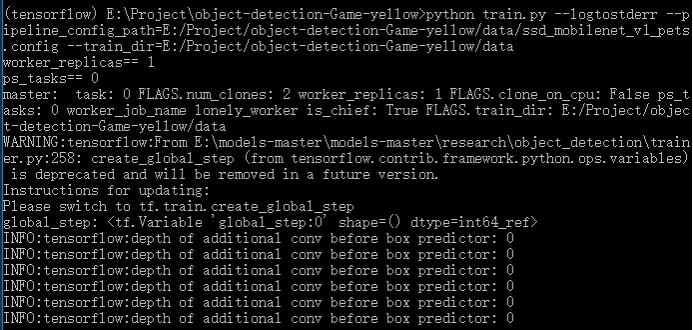
使用TensorBoard进行监测
1.在输入训练的命令后,data文件夹下会生成如下文件,该文件存放训练过程中的中间数据,并可以用图形化的方式展现出来。

2. 新打开一个命令提示符窗口,首先激活TensorFlow,然后输入如下命令:
tensorboard --logdir==training:your_log_dir --host=127.0.0.1
其中,your_log_dir为工程目录中存放训练结果的文件夹目录,把目录地址拷贝出来将其替代。
3.打开浏览器,在地址栏输入:localhost:6006,即可显示tensorboard:
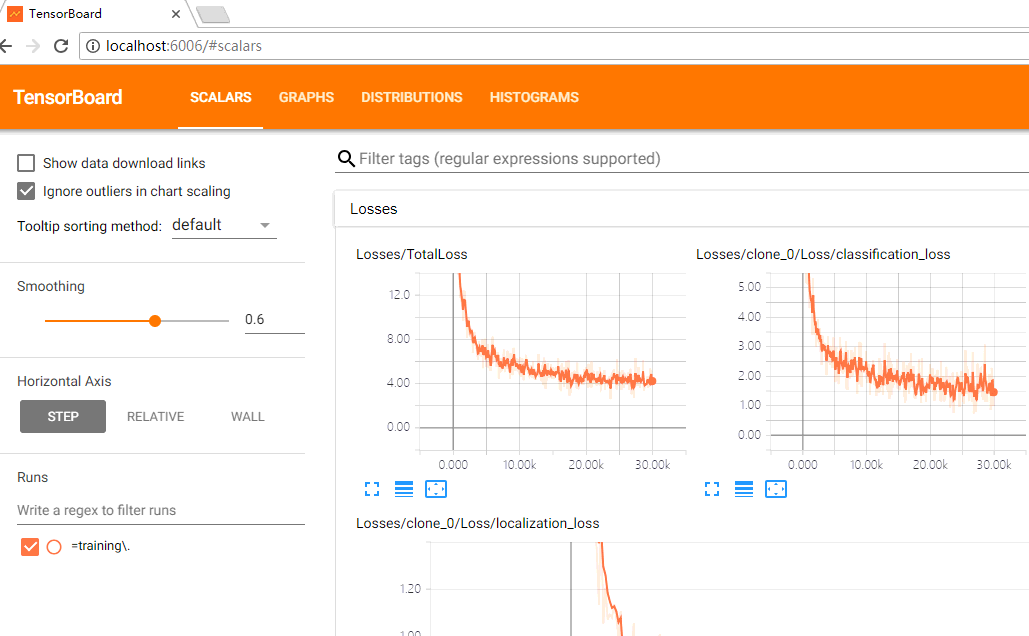
导出训练结果
1.训练过程中将在training目录下生成一堆model.ckpt-*的文件,如下:
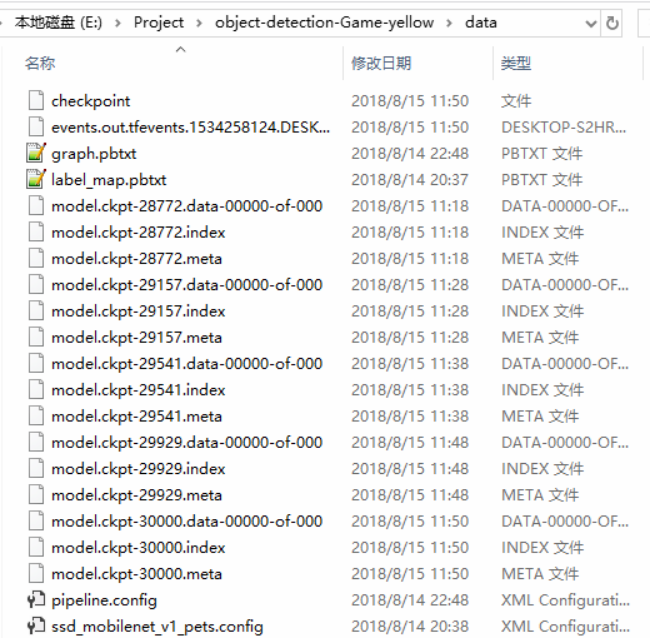
选择相应步数的模型,使用export_inference_graph.py(其在object detection目录下)导出pb文件,命令如下:
python export_inference_graph.py --pipeline_config_path=E:\Project\object-detection-Game-yellow\data\ssd_mobilenet_v1_pets.config --trained_checkpoint_prefix ./data/model.ckpt-30000 --output_directory ./data/exported_model_directory
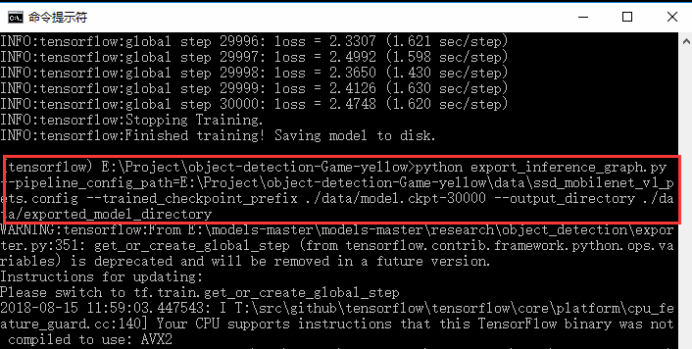
运行命令后,会在工程的data目录下生成名为exported_model_directory文件夹,如下:
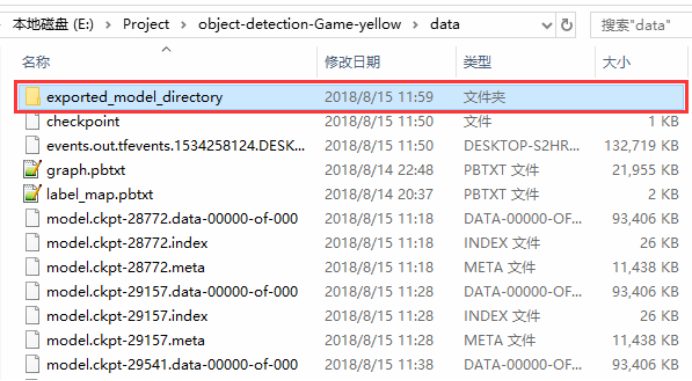
文件夹内容如下:

其中,frozen_inference_graph.pb就是我们以后将要使用的模型结果。
获取测试图片
1. 新建test_images文件夹和get_testImages.py文件,并加入以下代码,如下:
1 from PIL import Image 2 import os.path 3 import glob 4 5 annotations_test_dir = "E:\\Project\\object-detection-Game-yellow\\annotations\\test\\" 6 Images_dir = "E:\\Project\\object-detection-Game-yellow\\Images" 7 test_images_dir = "E:\\Project\\object-detection-Game-yellow\\test_images" 8 i = 0 9 for xmlfile in os.listdir(annotations_test_dir): 10 (filepath, tempfilename) = os.path.split(xmlfile) 11 (shotname, extension) = os.path.splitext(tempfilename) 12 xmlname = shotname 13 for pngfile in os.listdir(Images_dir): 14 (filepath, tempfilename) = os.path.split(pngfile) 15 (pngname, extension) = os.path.splitext(tempfilename) 16 if pngname == xmlname: 17 img = Image.open(Images_dir+"\\" + pngname + ".png") 18 img.save(os.path.join(test_images_dir, os.path.basename(pngfile))) 19 print(pngname) 20 i += 1 21 print(i)
第5、6、7行,分别是annotations\test文件夹路径、Images文件夹路径和test_images文件夹路径,运行python文件,获取测试图片并存储到test_images文件夹目录下。

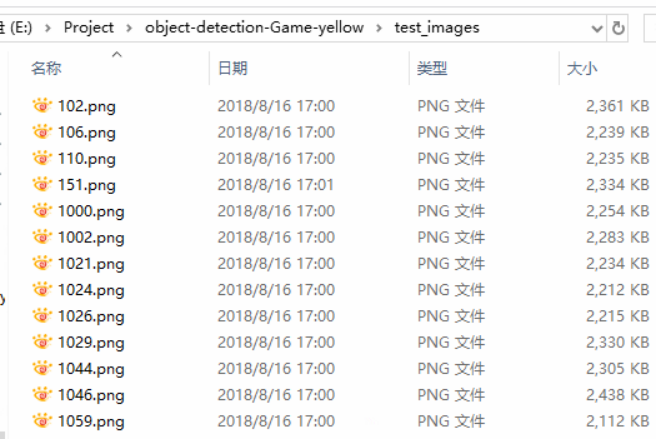
批量保存测试结果
1. 在工程目录下新建results文件夹和get_allTestResults.py文件并加入如下代码,我们将使用前面训练出的模型批量测试test_images文件夹中的图片并保存到results文件夹中,
1 # -*- coding: utf-8 -*- 2 import os 3 from PIL import Image 4 import time 5 import tensorflow as tf 6 from PIL import Image 7 import numpy as np 8 import os 9 import six.moves.urllib as urllib 10 import sys 11 import tarfile 12 import zipfile 13 import time 14 15 from collections import defaultdict 16 from io import StringIO 17 from matplotlib import pyplot as plt 18 # plt.switch_backend('Agg') 19 from utils import label_map_util 20 21 from utils import visualization_utils as vis_util 22 23 PATH_TO_TEST_IMAGES = "E:\\Project\\object-detection-Game-yellow\\test_images\\" 24 MODEL_NAME = 'E:/Project/object-detection-Game-yellow/data' 25 PATH_TO_CKPT = MODEL_NAME + '/frozen_inference_graph.pb' 26 PATH_TO_LABELS = MODEL_NAME+'/label_map.pbtxt' 27 NUM_CLASSES = 32 28 PATH_TO_RESULTS = "E:\\Project\\object-detection-Game-yellow\\results2\\" 29 30 31 def load_image_into_numpy_array(image): 32 (im_width, im_height) = image.size 33 return np.array(image.getdata()).reshape((im_height, im_width, 3)).astype(np.uint8) 34 35 36 def save_object_detection_result(): 37 IMAGE_SIZE = (12, 8) 38 # Load a (frozen) Tensorflow model into memory. 39 detection_graph = tf.Graph() 40 with detection_graph.as_default(): 41 od_graph_def = tf.GraphDef() 42 # loading ckpt file to graph 43 with tf.gfile.GFile(PATH_TO_CKPT, 'rb') as fid: 44 serialized_graph = fid.read() 45 od_graph_def.ParseFromString(serialized_graph) 46 tf.import_graph_def(od_graph_def, name='') 47 # Loading label map 48 label_map = label_map_util.load_labelmap(PATH_TO_LABELS) 49 categories = label_map_util.convert_label_map_to_categories(label_map, max_num_classes=NUM_CLASSES, 50 use_display_name=True) 51 category_index = label_map_util.create_category_index(categories) 52 # Helper code 53 with detection_graph.as_default(): 54 with tf.Session(graph=detection_graph) as sess: 55 start = time.time() 56 for test_image in os.listdir(PATH_TO_TEST_IMAGES): 57 image = Image.open(PATH_TO_TEST_IMAGES + test_image) 58 # the array based representation of the image will be used later in order to prepare the 59 # result image with boxes and labels on it. 60 image_np = load_image_into_numpy_array(image) 61 # Expand dimensions since the model expects images to have shape: [1, None, None, 3] 62 image_np_expanded = np.expand_dims(image_np, axis=0) 63 image_tensor = detection_graph.get_tensor_by_name('image_tensor:0') 64 # Each box represents a part of the image where a particular object was detected. 65 boxes = detection_graph.get_tensor_by_name('detection_boxes:0') 66 # Each score represent how level of confidence for each of the objects. 67 # Score is shown on the result image, together with the class label. 68 scores = detection_graph.get_tensor_by_name('detection_scores:0') 69 classes = detection_graph.get_tensor_by_name('detection_classes:0') 70 num_detections = detection_graph.get_tensor_by_name('num_detections:0') 71 # Actual detection. 72 (boxes, scores, classes, num_detections) = sess.run( 73 [boxes, scores, classes, num_detections], 74 feed_dict={image_tensor: image_np_expanded}) 75 # Visualization of the results of a detection. 76 vis_util.visualize_boxes_and_labels_on_image_array( 77 image_np, 78 np.squeeze(boxes), 79 np.squeeze(classes).astype(np.int32), 80 np.squeeze(scores), 81 category_index, 82 use_normalized_coordinates=True, 83 line_thickness=8) 84 85 final_score = np.squeeze(scores) 86 count = 0 87 for i in range(100): 88 if scores is None or final_score[i] > 0.5: 89 count = count + 1 90 print() 91 print("the count of objects is: ", count) 92 (im_width, im_height) = image.size 93 for i in range(count): 94 # print(boxes[0][i]) 95 y_min = boxes[0][i][0] * im_height 96 x_min = boxes[0][i][1] * im_width 97 y_max = boxes[0][i][2] * im_height 98 x_max = boxes[0][i][3] * im_width 99 x = int((x_min + x_max) / 2) 100 y = int((y_min + y_max) / 2) 101 if category_index[classes[0][i]]['name'] == "tower": 102 print("this image has a tower!") 103 y = int((y_max - y_min) / 4 * 3 + y_min) 104 print("object{0}: {1}".format(i, category_index[classes[0][i]]['name']), 105 ',Center_X:', x, ',Center_Y:', y) 106 # print(x_min,y_min,x_max,y_max) 107 plt.figure(figsize=IMAGE_SIZE) 108 plt.imshow(image_np) 109 picName = test_image.split('/')[-1] 110 # print(picName) 111 plt.savefig(PATH_TO_RESULTS + picName) 112 print(test_image + ' succeed') 113 114 end = time.time() 115 seconds = end - start 116 print("Time taken : {0} seconds".format(seconds)) 117 118 119 save_object_detection_result()
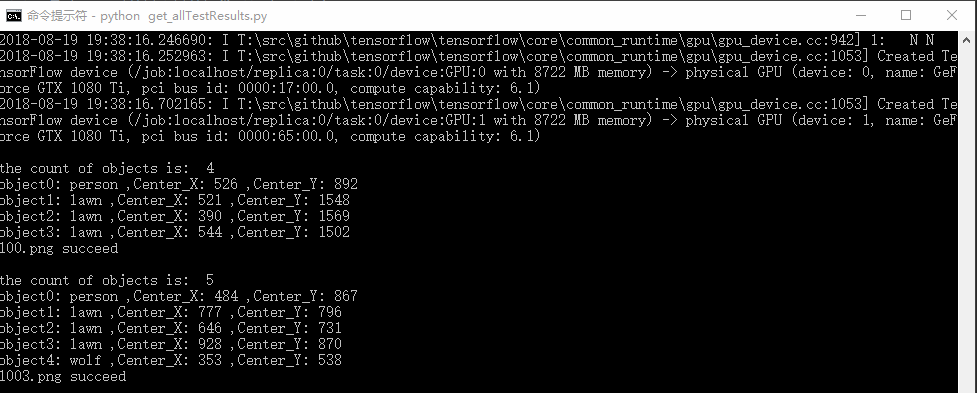
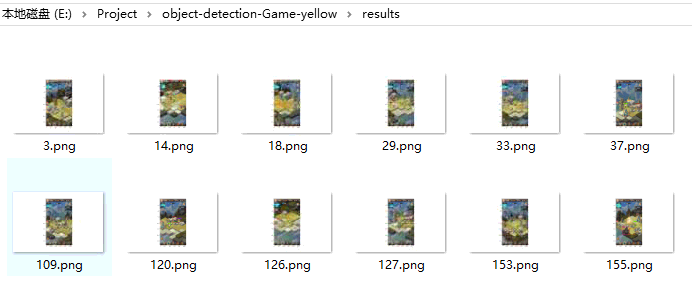
最后,我们就可以使用results中的测试结果进行准确率的计算,查看训练效果及后期优化。
总结





